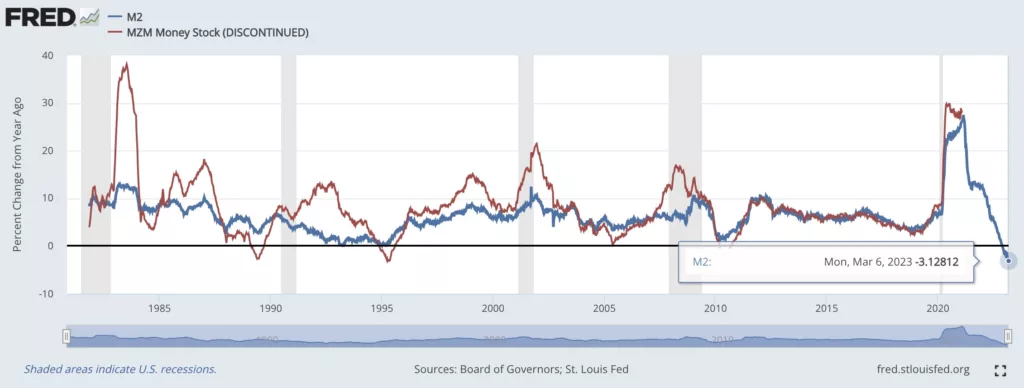Deposits in US banks have fallen by more than anytime since the 1980s with March seeing a sharp dive of close to 22%.
That’s significantly higher than in 2008 when long queues at Northern Rock and the bankruptcy of the Lehman Brothers led to a fall of just 10% in deposits.
In 1981 however, amid shock therapy by the then Fed chair Paul Volcker, deposits fell by as much as 38% in one month.
Making this drop drastic and almost the worst as deposits fell by 5% in yearly terms, about as much as in 1981, from $18.2 trillion to $17.2 trillion.
They only slightly recovered by the end of March as the banking crisis, which led to the collapse of three US banks, faded away.
Some of this decrease therefore will be more medium to longer term as the Federal Reserve Banks have also reduced their balance sheet from about $9 trillion to $8.6 trillion.
The M2 money supply has also contracted for the first time in nearly a century, down 3% in a seasonally adjusted basis as of March.

M2 is one of the broader measures of money supply, containing savings and mutual funds on top of M1.
It fell from a peak of $21.7 trillion in July to $21 trillion, marking a sharp contraction of historic proportions.
And yet, the United States government debt is 50% higher than the entire M2, at $31 trillion and expanding at between half a trillion to a trillion a year.
How that will be paid back without printing money is anyone’s guess, but for now there’s a liquidity crunch ongoing at a speedy rate with potential ramifications for the economy as the dollar becomes deflationary from the June peak and burns at a higher rate than Ethereum.
They criticized bitcoin for being deflationary in monetary supply and claimed the deflationary nature of gold was to blame for economic crisis in the 19th century, but we’ve had plenty of such crisis in this 21st century and we’re yo-yoing from high inflation to deflation.
Still, these might be temporary re-adjustments following the March 2020 shock, so the economy might not feel them as much as it would have otherwise.
But this centralized orchestration of the entire economy with insufficient and estimated data, may well exacerbate economic crisis, if not cause them.
Most therefore now think Fed is done with hiking and some are pushing it to start consider cutting, but can this big ship high up there in the tower change gears quickly?
Fed’s chair Jerome Powell suggested last month there won’t be any cuts this year. Setting aside how he knows while claiming Fed is data driven, a mistake while re-adjusting can’t be ruled out.
That might cost the economy through a longer and/or deeper recession, and it is anyone’s guess at this point just what we might find out is new since the 1940s due to this historic monetary contraction.
Making the next few months one of uncertainty in traditional finance as the market keeps wondering whether the March crisis was just a prelude in a structurally different financial world.
- SEO Powered Content & PR Distribution. Get Amplified Today.
- Platoblockchain. Web3 Metaverse Intelligence. Knowledge Amplified. Access Here.
- Minting the Future w Adryenn Ashley. Access Here.
- Source: https://www.trustnodes.com/2023/04/19/1-trillion-withdrawn-from-us-banks



